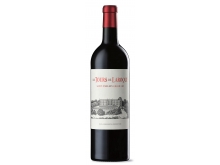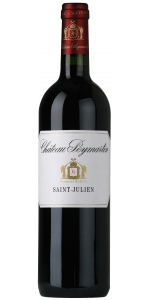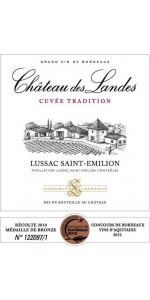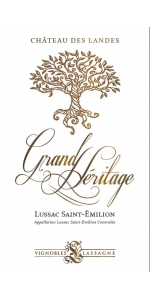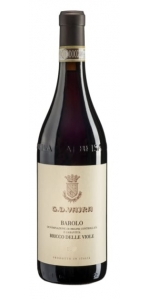Tours de Laroque Saint Emilion 2019
6 bottles with free shipping for: $240.00
12 bottles with free shipping for: $420.00
| BUY MORE! SAVE MORE! | ||||||||||||||||||||
|
Tours de Laroque Saint Emilion is made from 96% Merlot and 4% Cabernet Franc.
Les Tours de Laroque Saint-Emilion Grand Cru is the second wine from Chateau Laroque, a selection of over 50 year-old vines that shows finesse, purity and authenticity of this great terroir.
The wine is particularly attractive and approachable when young with its bright, floral and spicy character. It is elegant and velvety, has a fresh salinity and a noble texture, and offers good acidity with firm tannins.
Review:
"Lots of dark chocolate on the nose with blueberries, ripe blackberries, plums, dried lavender, toast and mahogany. It’s medium-to full-bodied with firm, chewy tannins. Needs time to soften. Try in 2025."
- James Suckling (January 2022), 91 pts
Château Laroque, with its mighty 12th century tower ("Tours" in French), is an imposing feature in the Saint-Emilion area. Located to the south of the village of Saint-Christophe-des-Bardes, the estate appears as a defensive stronghold watching over Saint Emilion. Built on a plateau of limestone rock, from which the estate took its name, this outstanding location has been owned by several families, each one of them making their contribution and imparting an added touch of soul to the place.
The restoration of the cellars carried out in the 19th century was the work of Maurice Dufaure de Rochefort, a keen enthusiast of Saint-Emilion wines. Once the new cellars had been completed, he refocused the economic activity of Château Laroque solely on vine-growing.
Chateau Peymartin Saint-Julien is made from 65% Cabernet Sauvignon, 25% Merlot, 5% Petit Verdot.
Peymartin is the second wine of Gloria, produced using the youngest vines (average 40 years-old) on the estate.
After a manual harvest, the grapes are vinified in thermo regulated stainless steel vats with malolactic in barrel. Peymartin spends approximately one year in cask followed by additional aging at the estate in bottel prior to release. The ensuing style of wine is typically a lighter and more elegant St. Julien, known for its early drinkability and charming character.
Tasting Notes:
Deep ruby-garnet in appearance, Peymartin is classic left-bank Bordeaux. Aromas of dried tobaco, cedar, blackcurrant, and pungent cooking spices greet the nose. The palate is extremely elegant with ripe, yet structured tannins balanced by firm acidity, black fruits, savory earth, and hints of toasted vanilla. A balanced and persistent finish underlines the wine's quality as well as its ability to hold up in bottle.
Landes Cuvee Tradition Lussac Saint Emilion is made from 80% Merlot, 15% Cabernet Sauvignon and 5% Cabernet Franc
Color: deep ruby intense color.
Aroma: racy and aromatic nose with aromas of ripe red fruit.
Taste: this wine is silky, round and smooth first taste, with aromas of raspberries, and blackcurrant, powerful and complex finish.
Landes Cuvee Tradition Lussac Saint Emilion is made from 80% Merlot, 15% Cabernet Sauvignon and 5% Cabernet Franc
Color: deep ruby intense color.
Aroma: racy and aromatic nose with aromas of ripe red fruit.
Taste: this wine is silky, round and smooth first taste, with aromas of raspberries, and blackcurrant, powerful and complex finish.
Landes Cuvee Tradition Lussac Saint Emilion is made from 80% Merlot, 15% Cabernet Sauvignon and 5% Cabernet Franc
Color: deep ruby intense color.
Aroma: racy and aromatic nose with aromas of ripe red fruit.
Taste: this wine is silky, round and smooth first taste, with aromas of raspberries, and blackcurrant, powerful and complex finish.
Landes Cuvee Tradition Lussac Saint Emilion (half-bottle)is made from 80% Merlot, 15% Cabernet Sauvignon and 5% Cabernet Franc
Color: deep ruby intense color.
Aroma: racy and aromatic nose with aromas of ripe red fruit.
Taste: this wine is silky, round and smooth first taste, with aromas of raspberries, and blackcurrant, powerful and complex finish.
Landes Grand Heritage Lussac Saint Emilion is made from 100 percent Merlot.
First vintage of this wine was 2010 to pay tribute to the founding father of Chateau des Landes - Paul Lassagne. He gave the family a great legacy of terroir, passion and know-how to craft this great cuvee produced from a selection of the finest grapes that are vinified and aged in 600 liter French oak foudres, just like it was done in the old days. The resulting wine is complex and aromatic offering bold aromas and flavors of dark berries, floral tones, spice, oak and vanilla. The palate is onctuous and powerful, well structured with ripe tannins. Well balanced and a complex finish.
Average age of the Vines: 60 years Yield : 50 hectoliters / hectare. Grape picking: harvest by machine. Vats: Stainless steel thermoregulated and computerized. Fermentation: 45 to 50 days with a final 35°C warm steeping. Winemaking: Malolactic fermentation in new oak barrel. Ageing: 16 months in new French Oak barrels from Allier and Limousin. Annual production: 10,000 bottles. (833 cases)
G.D. Vajra Bricco Delle Viole Barolo is made from 100 percent Nebbiolo.
The Barolo Bricco delle Viole shows the signature verticality of its vineyard. The wine is beautifully layered and - while restrained as it’s always the case in the youth of Bricco delle Viole - it also shows a complexity of layers with purple flowers, sweet spices and mineral tones. The palate is noble, with a refined acid spine and profound tannins that promise a long aging potential.
Among the historical vineyards of Barolo, Bricco delle Viole is the highest and the closest to the Alps. It rises from 400 to 480 meters above sea level, on the Western ridge of the village. Its name, “Hill of Violets”, originates from the flowers that blossom early here due to the perfect south exposure. Up above the fogs, Bricco delle Viole enjoys the earliest sunrise and the last sunset every day. Thanks to its vines dating back to 1949 and -now- 1931, a dramatic diuturnal temperature range and this pure light, Bricco delle Viole generates a sophisticated and profound Barolo DOCG of bright aromatics, chiseled tannins and subtle minerality. 2018 is a vintage that shows many nuances of Bricco delle Viole: beyond the signature verticality of this site, the wine offers high tones laced with mineral nuances and plenty of energy and youth.
Review:
A juicy Barolo, with vibrant acidity and a fluid profile that exudes cherry, raspberry, mown hay, mineral and eucalyptus aromas and flavors. Tight yet long, with excellent potential.
#26 Wine Spectator Top 100 of 2023
The last wine poured at my tasting at the winery is the G.D. Vajra 2019 Barolo Bricco delle Viole. With its high vantage point in the hills west of Barolo, Bricco delle Viole is a world apart in terms of soils (with Sant'Agata marl and fossils) and even harvest times. Slow and careful ripening like the kind that characterizes fruit in 2019 renders a very delicate and ethereal expression with floral tones, wild mint and licorice. This organic wine is solid in build and structure. Indeed, Isidoro Vaira remarks that Nebbiolo tannins have changed since the 1970s and 1980s.
-Wine Advocate 97+ Points
Jeweled in appearance, the 2019 Barolo Bricco Delle Viole may be the best wine I have tried yet from Vajra. Its gorgeous and alluring perfume of fresh roses is followed by a Burgundian, elegant red with incredible length and no harsh edges, fine and present tannins, and beautiful, graceful concentration. It is drinking well now, and I will be trying to get my hands on as much of this as possible. Drink 2025-2045.
-Jeb Dunnuck 97 Points
- back
The Opus One 2018 offers profuse aromas of blackberry, cassis, and black cherry. Elegant notes of violets, white pepper and rose petals follow and together they deliver a very seductive bouquet. The seamlessly layered flavors build to a crescendo of fresh and juicy black-fruit, accented with hints of orange zest, licorice and dark chocolate. Beautifully balanced, the smooth round tannins and fresh acidity combine to create a soft, creamy mouthfeel and extend the flavors into a long persistent finish.
Blend: 84% Cabernet Sauvignon, 6% Petit Verdot, 5% Merlot, 4% Cabernet Franc, 1% Malbec
Reviews:
Extremely perfumed and floral with lavender, lilacs and violets to the sweet, ripe berries, such as blackberries and blackcurrants. Some slate and graphite, too. It’s full-bodied, yet ever so balanced and refined, with super fine tannins that last for minutes. Fresh herbs, such as bay leaf and lemon grass highlight the dark fruit. The quality of tannin is exquisite with wonderful polish and refinement. Lasts for minutes. So wonderful to taste now, but better after 2026.
99 Points James Suckling
Sokol Blosser 'Orchard Block' Pinot Noir 2021 is made from 100 percent Pinot Noir.
VINTAGE HIGHLIGHTS
2021 was the 2nd warmest growing season we have ever seen since 2015. We also got to add a new term to the dictionary: "Heat Dome". Three straight days of triple digit temperatures in late June breaking heat records for the Willamette Valley. Bud break started like usual in the middle of April. We had the driest March through May that the Willamette Valley has seen through 128 years of record keeping! Bloom also appeared on time in early/mid June. While late June brought the “Heat Dome”, our grapes made it through thanks to bloom being finished at all our sites and there still being soil moisture, so they grew like crazy over those three days of hellish temperatures. While July and August turned out to be exceedingly hot and dry, September arrived with little rain which that allowed us to fully ripen the grapes. The hot and dry summer made for fruit that was extremely clean, resulting in excellent fermentations. All in all, mother nature gave us something to be grateful for on our 50th anniversary.
WINEMAKING
The grapes were carefully hand harvested from the Orchard Block (on our Estate vineyard) on September 25th. The fruit was hand sorted to remove any flawed bunches and de-stemmed, half went directly into 3-ton stainless steel fermenters and the other half went in to oak upright fermenters. Fermentation took place over 10-14 days using ambient yeast with punchdowns for cap management. After the long, cool fermentation, the wine was pressed off at dryness and then barrel aged for 16 months in 100% French oak barrels with 17% new oak.
WINE PROFILE
Our 2021 Orchard Block Estate Pinot Noir has bright notes of red cherry, red currant, and a touch of nutmeg on the nose. On the palate, the fruit continues with red cherry, raspberry, and red currants followed by a subtle hint of clove. This is a delicate Pinot Noir with bright acidity with a medium finish.
PAIRINGS
Orchard Block Pinot Noir pairs with a classic roasted turkey, creamy cacio e pepe, and the Oregon favorite, wild mushroom risotto.
Review:
Powerful floral aromatics as violets introduce deep blue fruits, forest floor, and a note of iodine. This old 2.5ha plum and cherry orchard produces wines of depth, elegance and restrained power. The palate is lushly fruited with ripe red raspberries, clove and turned earth. The finish is elegant and long-lived.
Decanter 93 Points

